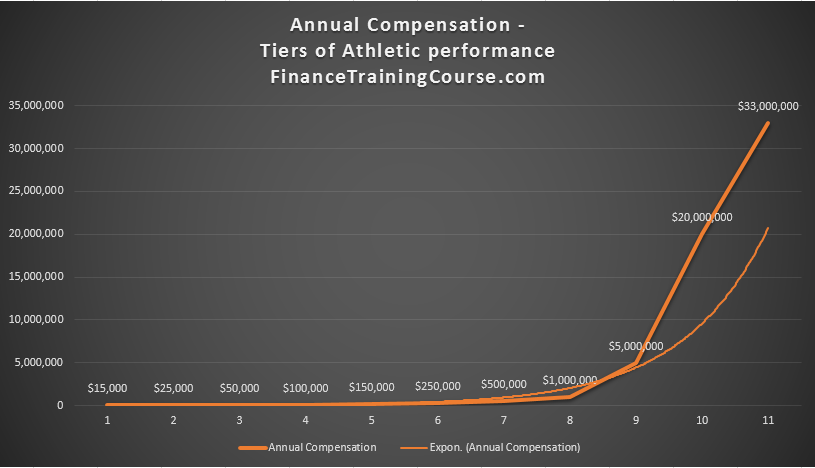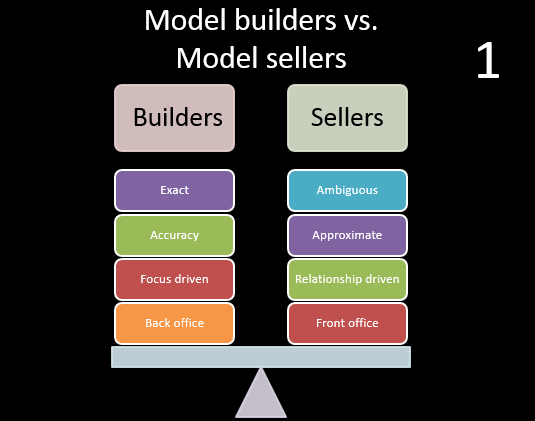Non traditional Actuarial Careers.
On 19th October 2016, the Pakistan Society of Actuaries graciously invited me to speak on non traditional actuarial careers to an audience comprising largely of actuarial students. The objective was to give them a purview of all the non-actuarial things actuaries do (especially me). While senility, old age and the absence of an official record make it difficult to remember exactly what I said, here is what I think I did say in roughly 30 minutes with some additions and deletions.
This is the first installment. The initial twenty minutes focused on standing out from the crowd and why does that matter for your actuarial future. There were nine more points on my list. They will follow in the weeks to come – see rationality is overrated and slower than the flash, bigger than a duck.

There was a time when data, relationships and numerical methods were the sole domain of the quantitatively inclined. If you were good with numbers and spread sheet modeling you could name your price and your desk in the corner office because not everyone could do what you did. The tools to extract and play with data were neither common place nor well understood. The models hidden behind lore of black magic, wizardry and dark arts.
Tis was the golden age for Quants and by extension actuaries. We loved numbers. We loved relationships. We loved data and models. And they loved us right back. With interesting work, comfortable roles, work life balance and pay scales that would become the source of envy across generations.
That time is now quickly becoming part of history. If we are not careful, what we view today as the actuarial profession may soon be heading that way too (the way of historical records).
With the increase in computational power and the emphasis on self-paced learning two things have happened. There is an abundance of great teachers and content online that can decode that most awkward of concepts, the coolest of Excel techniques in under five minutes. There is also power available at your fingertips that can take the same concepts and tools and create eye popping images and presentation and put them in front of a diverse audience. If you play your cards right, you can even become an overnight internet sensation drawing traffic from the farthest reaches of the globe.
In 1996 when I first came across Stochastic Calculus and Continuous Time Finance, the text book prescribed by the Society of Actuaries was David Shimko’s Finance in Continuous Time. Twenty years later when I see that book, all I can remember is the agony I went through trying to decipher it. It wasn’t the book, the fault didn’t lie with Professor Shimko. It was me. I was a terrible student with no prior background or experience in a field; no resources or guides who could hold my hand or help me out. The internet existed but I had no idea where to look or ask for help. Even if I did in the summer of 1996, there wasn’t much to be found online in that field.
Three years later at Columbia it took the combined efforts of Maria Vassalou, Mark Broadie, Howard Corb, Lars Tiege Nielson – four accomplished professors and outstanding teachers and Carlos and Chen my group partners in security pricing and Continuous Time Finance to hack through the cobwebs in my mind and bring some clarity to the subject. It was awkward, it was painful and it lead to the end of the PhD dream. Every once in a while it is better to acknowledge your personal limits than continue bashing your head on the wall.
Today all you need to do is do a Google search on continous time finance book pdf and 1.9 million results pop up. If you want a lecture just replace pdf with filetype:ppt and 900 power point presentations are available for your review. You want lectures, hop over to YouTube and discover 750 filtered lectures (of over 20 minutes) including a few from MIT OCW on a subject that would bring tears of boredom to a normal human being.
The point that I am trying to make is that the selection process, the ethos of exam taking, the eleven year cycle that it took me to become a Fellow Society of Actuaries is no longer required to master the dark art of data analysis, applied financial modeling, computational finance, partial differential equations or even actuarial science. What is worse is the competition of actuaries is not limited to other actuaries but includes anyone with a hunger to succeed, a mathematical mind, a desire to learn and a decent internet connection.
Despite the doom and gloom, I still think that this is one of the best thing that is happening to the profession. An external stimuli linked to survival is inevitably a source of evolutionary response. This arrival of young blood, fresh perspectives, new tools and credible challenges to a three century old brand will lead to improvements that we can’t foresee right now.
Till that happens, the question is how do you plan to make your work stand out from the crowd? With thousands of new test takers and candidates with initial exams under their belt, what are your plans on getting noticed?
Actuarial careers. Find your niche and start practicing now.
I have always loved relationships. Especially identifying and extracting them from large data sets. That and showing and teaching the world what I do, every day.

I wasn’t sure if this was what I wanted to focus on in the beginning but as I grew as a professional, extracting meaningful relationships that could be put to work the next day became the one thing, side by side with teaching, that I consistently enjoyed. When my last boss asked me, Jawwad, what do you want to do when you grow up, at my annual review, teaching was not the answer he expected.
It took years of practice, disasters, fiascoes, courage, commitment and occasional acts of stupidity to get good at it. Stupidity here is relative. Sometimes acts of great stupidity lead to brilliant insights; while others result in significant personal and financial loss. I did a bit of both.
But there is a difference between being good at something, of being aware that you are good at it and convincing the world that this is the case. Your audience at large looks at multiple signals before they decide to vote in your favor by giving you work, engaging you as a consultant, teacher or trainer.
The ideal state is one where the quality of your work is so outstanding that the world beats a path to your door, booking you in advance for many years to come.
We wish that everyone could be that fortunate but it is rare. To carve out a comfortable living it is perfectly acceptable to just stand out just enough, not by a lot. You don’t need to be Usain Bolt and win 4 gold medals across your events at three of the most recent Olympics games.

At a lower scale success can be just as profound with a gold in the sprints in the Asian games. It’s not going to be the 33 million US$ that Mr. Bolt banked in 2016 but it will be enough. The top trainers/speakers in my field charge 150,000 dollars per day plus associated expenses for a training engagement. I will be just as happy with a measly bottom of the pyramid rack rate of US$ 10,000 a day plus business class travel. A few days at that rate every few months and I can take alternate months off from work.
The path to these stratospheric charge out rates is through specialization. Specialization and focus. You can’t be everything for everyone, so be exceptionally good at a few things for a few people. I was lucky that this selection was made very early for me. Three overlapping interests worked together to create a much larger effect. Model building, writing and teaching.
My first role as an adjunct was an accident. The primary adjunct lecturer was transferred overnight to Amsterdam leaving my alma mater in a fix. I heard on the grapevine that they were desperate and offered myself. My first class was a disaster. There were 60 students and my knees knocked but it was all uphill from that original disaster.
The first corporate training engagement was another lucky break. We went to pitch a training on an exotic topic, we received an interesting counter offer. It wouldn’t have been possible without the class room instruction time I had already clocked. I learnt a few valuable lessons over time.
The most important one – teaching is essentially show business. If you can entertain and engage your audience, you can be an effective teacher. If you can’t you will be consigned to the sidelines.
Writing was different. It took a while for me to figure out that you can’t really live off your books. Even longer to understand that writing as a side hobby and writing for the world to consume and react to your content are two different things. It took three textbooks, one self-published, two with a main stream text book publisher, for these lessons to sink in.
You have to do more.
The big surprise in all this were university courses. Corporate training rarely pushed me towards the deep end, but MBA and graduate students have always been a different breed. Every now and then you would be blessed with a true student in your class who would ask not one but a stream of difficult questions. The quest to answer these questions freshened up training materials and made you a better teacher. It also changed your relationship with students in the class. Rather than one way monologues classes became bi-directional exchanges. Teachers became students; students, teachers. Peers and equals. The best of all worlds.
My love affair with models certainly deserves a lot more space than just teaching and writing.
The downside of specialization and digging deeper is that you quickly arrive at a conflict faced by practitioners. A midlife crisis of sorts. The point where you realize that you can essentially throw the models out of the window. All your life you have been chasing complexity in search of the greater truth, the perfect spreadsheet and when you finally find it, it leaves you shocked.
Simpler is better.
Teaching brought this to the fore much quicker than planned. Smart clients have the same effect in consulting. A simple why or how in either setting, leads to implosion of perfectly crafted presentations by model sellers. And why should we do this? I don’t understand, could you please explain how exactly is this going to work in the current context? Yes, I realized it worked in Luxembourg, but is this really going to fly in Kabul?
Next time when you are looking for some fireworks to brighten your day, just ask why or how, sit back, relax and enjoy the façade crumble in slow motion.
All three of my books owe their existence to my students and their difficult questions. They didn’t just ask difficult questions, they also showed me the flaws in the many models I made it my business to sell. The first edition of Models at Work (it was called Risk Frameworks and applications then) had just over 200 pages. The next 380, the third and final 600 and change.
Remember these were seminal years. Beginning with the 2008 financial crisis, the rating cut heard across the world in the middle when S&P surprised everyone with a notch adjustment against a AAA rated global economic power house and the financial shock wave that was Brexit this June 2016.

If you have managed to retain your faith in the applicability of Brownian motion to financial markets through all that you deserve much more than a medal. I almost opted for a padded cell.
The biggest contributor to new content across the three editions were the many caveats and work around required to address fundamental flaws we had debated during my lectures. Essentially my many attempts to answer the how’s and why’s asked by significantly smarter students. And the latest edition still doesn’t include answers to the questions that truly stumped me.

It was a transition I personally witnessed over a decade as I crossed over from a flag burning, chest thumping model fanatic/slob with a day old stubble to the significantly quieter version who now simply says – that is not how it is supposed to work – and then goes back inside his hiding hole. Those who can, do; those who can’t teach.
Actuarial careers. Front office vs. Back office roles.
There is one last point I need to make, before we wrap up this short rant on doing more and standing out. Some of us are made to work with clients, some of us are not. Some of us are at peace in the background cracking code, running numbers in our low key invisible mode. Some of us like the lime light, shaking hands, going out on a limb, selling, being everything but invisible.
You don’t have to be both.
In treasury lingo we call the client facing roles, front office roles – the number crunching, code cracking roles back office roles. There is some overlap but when you tag someone as front office talent versus back office resource, the implication is quite clear. One can talk on the phone, handle a client and run an account. The other puts up his or her best performance away from the lime light, in a corner immersed within the world of numbers and models.

Some can do both, but you generally pick up a preference early in the game. Figure out where you want to be and what kind of a choice does that represent, personally as well as professionally. The sooner you figure it out, the more easily you will be able to manage the conflict in your professional life as a quant as well as an actuary.
That is all she wrote gents for tonight. Next episode in a few days if I can find the time and the resolve to recall what came next. Stay tuned.
Note: On athletic compensation also see it’s really hard to make a living as an olympian.
